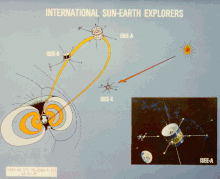ISEE-2
[2] The purposes of the mission were: (1) to investigate solar-terrestrial relationships at the outermost boundaries of the Earth's magnetosphere, (2) to examine in detail the structure of the solar wind near the Earth and the shock wave that forms the interface between the solar wind and the Earth's magnetosphere, (3) to investigate motions of and mechanisms operating in the plasma sheets, and (4) to continue the investigation of cosmic rays and solar flare effects in the interplanetary region near 1 AU.
The three spacecraft carried a number of complementary instruments for making measurements of plasmas, energetic particles, waves, and fields.
The mother/daughter portion of the mission consisted of two spacecraft (ISEE-1 and ISEE-2) with station-keeping capability in the same highly eccentric geocentric orbit with an apogee of 23 Earth radii (Re).
[1] During the course of the mission, the ISEE-1 and ISEE-2 orbit parameters underwent short-term and long-term variations due to solar and lunar perturbations.
Early results from duo stated that by having two spacecraft, the "spatial and temporal variations in the magnetosphere and solar wind" could be detected.
[3] This experiment was designed to determine, by using identical instrumentation on the mother/daughter spacecraft, the spatial extent, propagation velocity, and temporal behavior of a wide variety of particle phenomena.
[7] This experiment was designed to study plasma velocity distributions and their spatial and temporal variations in the solar wind, bow shock, magnetosheath, magnetopause, and magnetotail (within the magnetosphere).
[8] This experiment was designed to study, by means of identical instrumentation on the mother/daughter spacecraft, the spatial and temporal variations of the solar wind and magnetosheath electrons and ions.
[9] This experiment was designed to identify and to study plasma instabilities responsible for acceleration, source and loss mechanisms, and boundary and interface phenomena throughout the orbital range of the mother/daughter satellites.
A proton telescope and an electron spectrometer were flown on each spacecraft to measure detailed energy spectra and angular distributions.
The phase was compared against a phase-coherent signal transmitted from the mother to the daughter by modulation onto a carrier of frequency high enough (272.5-MHz) to be unaffected by the ambient plasma.
[11] In this experiment, a single-axis search coil magnetometer with a high permeability core and two electric field dipoles (30 m (98 ft) tip-to-tip and 0.61 m (2 ft 0 in)) measured wave phenomena occurring within the magnetosphere and solar wind in conjunction with a similar experiment (1977-102A-07) flown on the mother spacecraft.
The instrumentation was composed of two elements: (1) a high-time-resolution spectrum analyzer with 16 frequency channels (identical to those on ISEE 1) from 5.62-Hz to 31.1-kHz where all channels were sampled 1 or 4 times per seconds, depending on bit rate; and (2) a wide-band receiver to condition electric and magnetic waveforms for transmission to the ground via the special-purpose analog transmitter.
[12] This instrument was designed to measure the angular distributions and energy spectra of positive ions in the solar wind.
[13] The magnetic fields investigation selected for ISEE-1 and ISEE-2 had as its principal objectives the study of the magnetic signatures of magnetospheric phenomena and magnetohydrodynamic waves in and around the magnetosphere, and to provide supporting data for other experiments on the spacecraft such as the electric field, particle and plasma wave investigations.
